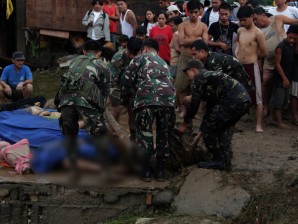CAGAYAN DE ORO – Philippine rescuers strived with mud, fatigue and the stench of death Sunday to help dazed survivors of devastating flash floods that have killed about 500 people.

Army troops belonging to 64th IB look into the wrath of nature brought about by typhoon Sendong in Iligan City Saturday. RICHEL V. UMEL/INQUIRER MINDANAO
Entire villages were washed away when tropical storm Washi whipped the southern Philippines on Saturday, leaving a trail of flattened homes, broken bridges and upended vehicles in the poverty-stricken country.
The government and the Philippine National Red Cross appealed for help to feed, clothe and house more than 35,000 people huddled in evacuation centres as soldiers battled to recover bodies from the cloying mud.
A 20,000-strong military force has been mobilized in a huge rescue and relief operation across the stricken north coast of the island of Mindanao, where the major ports of Cagayan de Oro and Iligan were worst hit.
Leonardo Vicente Corrales, a freelance journalist in Cagayan de Oro, which has a population of half a million people, told AFP that fast-rotting corpses were piling up by the dozen at local mortuaries.
“The bodies are decomposing too quickly because they are drowning victims – because there is muddy water in their bodies,” he said.
“They also cannot embalm them because they do not have water and are running out of formalin (formaldehyde embalming fluid).”
In some funeral parlors, the bodies had to be stacked up because there was not enough space, Corrales said.
He added: “Electricity has been restored in the center of the city but in the affected areas, there is no electricity and there is an emerging water crisis because there is no potable water in the houses.”
As an emergency measure, the city government in Cagayan de Oro has opened up fire hydrants and long lines are forming as residents queue for fresh water, Corrales said.
Relief workers said that 497 people had been killed and more than 160 left missing by tropical storm Washi.
Officials likened Washi to Typhoon Ketsana, one of the country’s most devastating storms which dumped huge amounts of rain on Manila and other parts of the country in 2009, leaving a death toll of over 460.
US Secretary of State Hillary Clinton sent condolences to the Philippines and said in a statement: “The US government stands ready to assist Philippine authorities as they respond to this tragedy.”
Britain also offered its condolences for the “tragic” loss of life.
Gwendolyn Pang, secretary general of the Philippine National Red Cross, warned that many more bodies could still be found.
“We are only counting the actual dead bodies that were sent to funeral parlours,” she told AFP.
“The affected area is so wide and huge and I believe they have not really gone to all areas to do a search.”
There could still be bodies inside houses that were carried off by the floods, Pang said.
“Our effort is shifting from rescue to restoring family links and rehabilitation,” Red Cross country chairman Richard Gordon said on ABS-CBN television.
“The priority is to alleviate human suffering,” he said, calling on the International Committee of the Red Cross to pitch in.
Benito Ramos, executive director of the National Disaster Risk Reduction and Management Council, said the government faced a formidable task in rehabilitation and reconstruction.
“The basic needs are water – we have given a lot of water,” he said.
Apart from those at evacuation centers – schools, government buildings and local gymnasiums – he said the disaster affected more than 100,000 people in one way or another who would need immediate help in rebuilding their lives.
The national government has begun airlifting mats, blankets and clothes to the affected populations of the south, who are being fed by local governments, he added.
Debris has to be cleared, electricity and drinking water have to be restored and damaged roads and bridges must be repaired, officials said.
Two army divisions – about 20,000 soldiers – based in Mindanao are leading the rescue and relief work. The island is the scene of a long-running insurgency led by Muslim separatists in the mainly Roman Catholic nation.